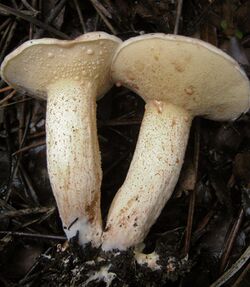Biology:Suillus bellinii
| Suillus bellinii | |
|---|---|

| |
| Scientific classification | |
| Domain: | Eukaryota |
| Kingdom: | Fungi |
| Division: | Basidiomycota |
| Class: | Agaricomycetes |
| Order: | Boletales |
| Family: | Suillaceae |
| Genus: | Suillus |
| Species: | S. bellinii
|
| Binomial name | |
| Suillus bellinii (Inzenga) Watling (1967)
| |
| Synonyms | |
| |
| Suillus bellinii | |
|---|---|
| Mycological characteristics | |
| pores on hymenium | |
| cap is convex or flat | |
| hymenium is adnate or decurrent | |
| stipe is bare | |
| spore print is brown | |
| ecology is mycorrhizal | |
| edibility: edible | |
Suillus bellinii, the Champagne bolete, is a pored mushroom of the genus Suillus in the family Suillaceae. It is found in coastal pine forests of southern Europe.
Description
The cap is initially convex and irregular, but becomes flatter with maturity, reaching up to 15 cm in diameter. The thick cuticle is brown and marbled with white to gray tones towards the periphery, especially in young specimens. It is very viscid during wet weather and peels easily - characteristics shared by many species of Suillus. The tubes are short, while the pores are small and coloured whitish, beige and, with maturity, yellowish. The pores may exude a reddish latex in fresh specimens.
The stem is short, cylindrical and coloured whitish, ornamented with reddish dots along its length. The firm flesh is whitish and yellowish in the stipe base and it is said to have a fruity odour and a pleasant taste. It is often infested with insect larvae. In a colour reaction test with ammonia solution, the flesh turns crimson.
The spores are ochre-brown in colour, fusiform, sized 8-10 by 3.5-4.5 μm.[1][2]
Habitat
Suillus bellinii is a thermophilic fungus, occurring in the Mediterranean region of southern Europe in coastal pine forests. It forms ectomycorrhizal associations with species of pine including Aleppo pine (Pinus halepensis), maritime pine (Pinus pinaster) and stone pine (Pinus pinea).[2][3]
Edibility
It is reportedly edible. Removal of the slimy cap cuticle is recommended.[1][3]
Similar species
Suillus bellinii often shares its habitat with Suillus mediterraneensis. The flesh of the latter species is yellow.[2]
References
- ↑ 1.0 1.1 "Suillus bellinii at Fungibalear.net" (in Spanish). Secció Micològica Museu Balear de Ciències Naturals. http://www.fungibalear.net/espanol/mostra_bolet_e.php?codi=71. Retrieved 2010-09-11.
- ↑ 2.0 2.1 2.2 Gerault, Alain (May 2005) (in French). Florule Evolutive des Basidiomycotina du Finistere – Homobasidiomycetes. 2.0.
- ↑ 3.0 3.1 "Suillus bellinii at Associazone Micologica Bresadola Gruppo di Messina" (in Italian). http://www.webalice.it/mondellix/Funghi%20S.htm#Suillus%20bellini. Retrieved 2010-09-08.
External links
Wikidata ☰ Q1267217 entry
 |

